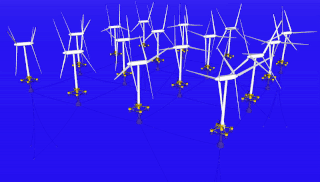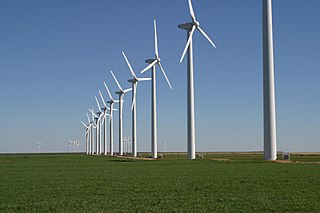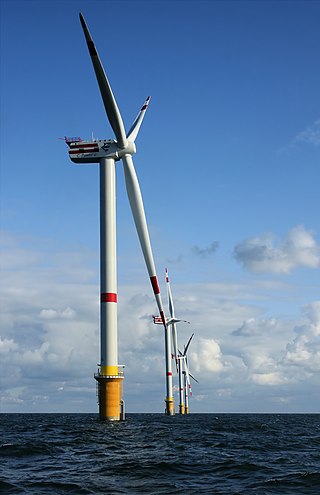
A power station, also referred to as a power plant and sometimes generating station or generating plant, is an industrial facility for the generation of electric power. Power stations are generally connected to an electrical grid.

Wind power is the use of wind energy to generate useful work. Historically, wind power was used by sails, windmills and windpumps, but today it is mostly used to generate electricity. This article deals mostly with wind power for electricity generation. Today, wind power is almost completely generated with wind turbines, generally grouped into wind farms and connected to the electrical grid.

A wind farm or wind park, also called a wind power station or wind power plant, is a group of wind turbines in the same location used to produce electricity. Wind farms vary in size from a small number of turbines to several hundred wind turbines covering an extensive area. Wind farms can be either onshore or offshore.

Enercon GmbH is a wind turbine manufacturer based in Aurich, Lower Saxony, Germany. It has been the market leader in Germany since the mid-1990s. Enercon has production facilities in Germany, Brazil, India, Canada, Turkey and Portugal. In June 2010, Enercon announced that they would be setting up Irish headquarters in Tralee.

Windy Hill Wind Farm is a wind power station near Ravenshoe on the Atherton Tableland, Queensland, Australia. It has 20 wind turbines with a generating capacity of 12 MW of electricity, providing enough power for about 3,500 homes. The cost of the project was A$20 million. It was the second wind farm to be constructed in Queensland after the 0.45Mw station on Thursday Island (1997).

Unconventional wind turbines are those that differ significantly from the most common types in use.

Wind power is a branch of the energy industry that has expanded quickly in the United States over the last several years. From January through December 2021, 379.8 terawatt-hours were generated by wind power, or 9.23% of electricity in the United States. The average wind turbine generates enough electricity in 46 minutes to power the average American home for one month. In 2019, wind power surpassed hydroelectric power as the largest renewable energy source in the U.S.

Wind power is the fastest-growing renewable energy technology in Scotland, with 9,347 megawatts (MW) of installed wind power capacity as of June 2020. This included 8,366 MW from onshore wind in Scotland and 981 MW of offshore wind generators.

The developing nations of Africa are popular locations for the application of renewable energy technology. Currently, many nations already have small-scale solar, wind, and geothermal devices in operation providing energy to urban and rural populations. These types of energy production are especially useful in remote locations because of the excessive cost of transporting electricity from large-scale power plants. The applications of renewable energy technology has the potential to alleviate many of the problems that face Africans every day, especially if done in a sustainable manner that prioritizes human rights.
The Siemens Energy Sector was one of the four sectors of German industrial conglomerate Siemens. Founded on January 1, 2009, it generated and delivered power from numerous sources including the extraction, conversion and transport of oil and natural gas in addition to renewable and alternative energy sources. As of October 1, 2014, the sector level has been eliminated, including the Siemens Energy Sector.

The Fowler Ridge Wind Farm is a wind farm in Benton County, Indiana, near the city of Fowler, IN about 30 miles (48 km) northwest of Lafayette and 90 miles (140 km) northwest of Indianapolis. Fowler Ridge was originally developed in 2005 and 2006 by Orion Energy, LLC and Vision Energy, LLC and later sold in 2007 to BP and Dominion Resources. The project was constructed beginning in 2008 in two phases and has a nameplate capacity of 600 MW.

Community wind projects are locally owned by farmers, investors, businesses, schools, utilities, or other public or private entities who utilize wind energy to support and reduce energy costs to the local community. The key feature is that local community members have a significant, direct financial stake in the project beyond land lease payments and tax revenue. Projects may be used for on-site power or to generate wholesale power for sale, usually on a commercial-scale greater than 100 kW.

A wind turbine is a device that converts the kinetic energy of wind into electrical energy. As of 2020, hundreds of thousands of large turbines, in installations known as wind farms, were generating over 650 gigawatts of power, with 60 GW added each year. Wind turbines are an increasingly important source of intermittent renewable energy, and are used in many countries to lower energy costs and reduce reliance on fossil fuels. One study claimed that, as of 2009, wind had the "lowest relative greenhouse gas emissions, the least water consumption demands and the most favorable social impacts" compared to photovoltaic, hydro, geothermal, coal and gas energy sources.
Xinjiang Goldwind Science & Technology Co., Ltd., commonly known as Goldwind, is a Chinese multinational wind turbine manufacturer headquartered in Beijing, China. Goldwind was a state-owned enterprise before 2007, with largest shareholders including Hexie Health Insurance, China Three Gorges Renewables Group, and the National Social Security Fund, state-controlled corporations holding almost 40% shares. Its founder, Wu Gang, is a Communist Party member and had a seat in the 12th National People's Congress.

Offshore wind power or offshore wind energy is the generation of electricity through wind farms in bodies of water, usually at sea. There are higher wind speeds offshore than on land, so offshore farms generate more electricity per amount of capacity installed. Offshore wind farms are also less controversial than those on land, as they have less impact on people and the landscape.
Langley Park Wind Farm is a wind farm near Langley Park, County Durham, England. It was developed by EDF Energy and is operated by Cumbria Wind Farms, the farm has a nameplate capacity of 8.2 MW, containing four REpower Systems' MM82 turbines each rated at 2.05MW.

As of 2019, renewable energy in Morocco covered 35% of the country’s electricity needs.
The following outline is provided as an overview of and topical guide to wind energy:

Wind power in the Philippines accounts for a total of 443MW as of 2020 according to the Department of Energy, covering about 1.6% of the country's total installed capacity for both renewable and non-renewable energy sources. When it comes to existing renewable energy sources in the country, wind power has a total share of approximately 5.4%. Despite currently being a small contributor to the country's energy mix, wind power installations have increased from 33MW in 2012-2013 to 337MW in 2014, 427MW in 2015-2018, and 443MW in 2019-2021. Moreover, the Department of Energy's National Renewable Energy Plan (NREP) 2020-2040 aims to commission 2,345MW of total wind power capacity by 2030. There has been a setback, however, as the wind power industry was moderately affected by COVID, particularly in the import of wind turbines. Due to this, several projects such as the Aklan onshore wind project got delayed. To further drive the wind energy sector in the country, an increased demand for renewable energy, greater government commitments, and reduced wind power tariff are needed.

Renewable energy in South Africa is energy generated in South Africa from renewable resources, those that naturally replenish themselves—such as sunlight, wind, tides, waves, rain, biomass, and geothermal heat. Renewable energy focuses on four core areas: electricity generation, air and water heating/cooling, transportation, and rural energy services. The energy sector in South Africa is an important component of global energy regimes due to the country's innovation and advances in renewable energy. South Africa's greenhouse gas (GHG) emissions is ranked as moderate and its per capita emission rate is higher than the global average. Energy demand within the country is expected to rise steadily and double by 2025.
















